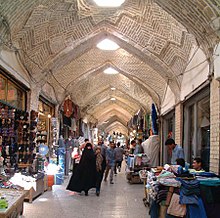Zanjan
| Zanjan | ||
|---|---|---|
|
|
||
| Basic data | ||
| Country: |
|
|
| Province : | Zanjan | |
| Coordinates : | 36 ° 40 ′ N , 48 ° 29 ′ E | |
| Height : | 1638 m | |
| Residents : | 386,851 (2010) | |
| Area code : | 241 | |
| Time zone : | UTC +3: 30 | |
Zanjan ( Persian زنجان Zanjān , DMG Zanǧān , also Sendschan ) is a city in the north-west of Iran with almost 400,000 inhabitants (as of 2010). It is the seat of the administration of the Zanjan province and is located 298 km northwest of Tehran .
From May 1850 to January 1851, Zanjan was the center of a Baba uprising in which, among other things, attempts were made to storm the local prison in order to free prisoners who were incarcerated for tax evasion.
In the last days of the Mohammad Reza Pahlavis regime , the traders in the Zanjan bazaar shut down operations for 45 days in protest against the lack of promised reforms.
Demographics
| year | population |
|---|---|
| 1900 | 20,000 |
| 1956 | 47,000 |
| 1966 | 59,000 |
| 1976 | 100.505 |
| 1986 | 214,982 |
| 1991 | 254.100 |
| 1996 | 286.295 |
Personalities
- Hafiz Abru , an important contemporary historian of Timur , died on June 25, 1430 in Zanjan.
- The Iranian philosopher and mystic of the 12th century, Shahāb ad-Dīn Yahyā Suhrawardī, came from the town of Suhraward ( Zanjan Province ) .
- Farah Ossouli , Iranian painter
Twin cities
Web links
Commons : Zanjan - collection of images, videos and audio files
- Friedrich Carl Andreas : Aganzana . In: Paulys Realencyclopadie der classischen Antiquity Science (RE). Volume I, 1, Stuttgart 1893, Col. 731-733.
Individual evidence
- ↑ Population data of the major cities of Iran (2010) ( Memento of the original from October 2, 2012 in the Internet Archive ) Info: The archive link was automatically inserted and not yet checked. Please check the original and archive link according to the instructions and then remove this notice. Table on the website of the Provincial Administration of South Khorassan (Persian)
- ^ Moojan Momen: The Social Basis of the Babi Upheavals in Iran (1848-53): A Preliminary Analysis . In: International Journal of Middle East Studies . tape 15 , no. 2 , May 1983, p. 157-183, p. 157 , doi : 10.1017 / S0020743800052260 .
- ↑ Mansoor Moaddel: The Shi'i Ulama and the State in Iran . In: Theory and Society . tape 15 , no. 4 , 1986, pp. 519-556, p. 526 , doi : 10.1007 / BF00159267 .
- ↑ Misagh Parsa: Entrepreneurs and Democratization: Iran and the Philippines . In: Comparative Studies in Society and History . tape 37 , no. 4 , 1995, p. 803-830, p. 815 , doi : 10.1017 / S0010417500019964 .
- ↑ a b c Julian Bharier: The Growth of Towns and Villages in Iran, 1900-66 . In: Middle Eastern Studies . tape 8 , no. 1 , January 1972, p. 51-61, p. 54 , doi : 10.1080 / 00263207208700193 .
- ↑ a b c Mehdi Amani: Situation demographique de l'Iran en 1991 . In: Population (French Edition) . tape 49 , no. 4/5 , 1994, pp. 1159-1169, p. 1163 , doi : 10.2307 / 1533676 .
- ↑ Lucy Dean (Ed.): Regional Surveys of the World: The Middle East and North Africa . tape 50/2004 , 2003, ISBN 1-85743-184-7 , pp. 424 .
- ^ V. Minorsky: Review of: Hafiz I-Abru. Chronique des Rois Mongols en Iran. Texts persan edite et traduit by K. Bayani. II: Traduction et Notes. xxiii + 173 pp. Paris: A. Maisonneuve, 1936. In: Bulletin of the School of Oriental Studies, University of London . tape 9 , no. 1 , 1937, p. 235 f ., doi : 10.1017 / S0041977X00070981 .
- ^ John E. Woods: The Rise of Tīmūrid Historiography . In: Journal of Near Eastern Studies . tape 46 , no. 2 , April 1987, pp. 81-108, p. 96 , doi : 10.1086 / 373225 .



